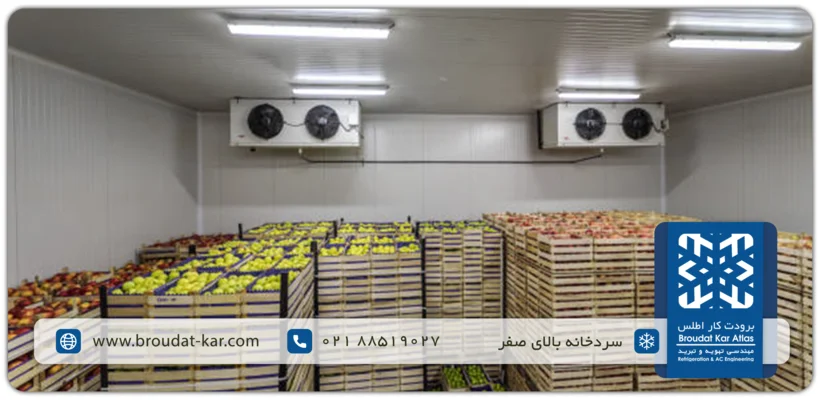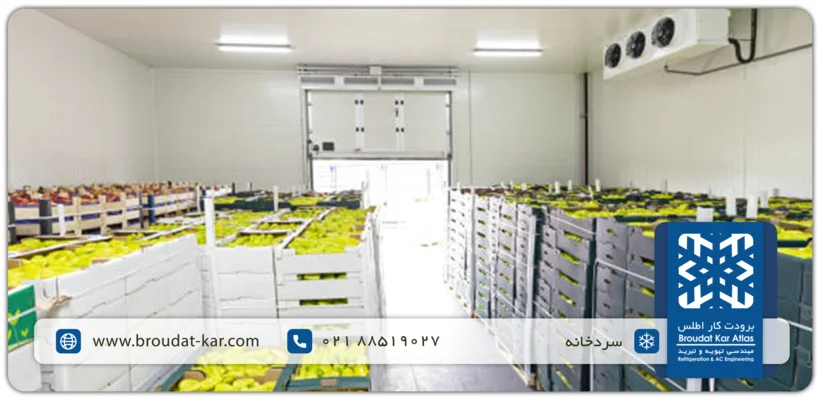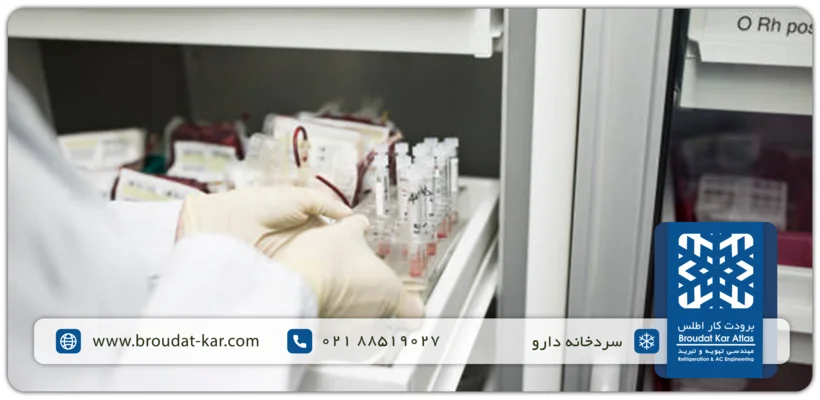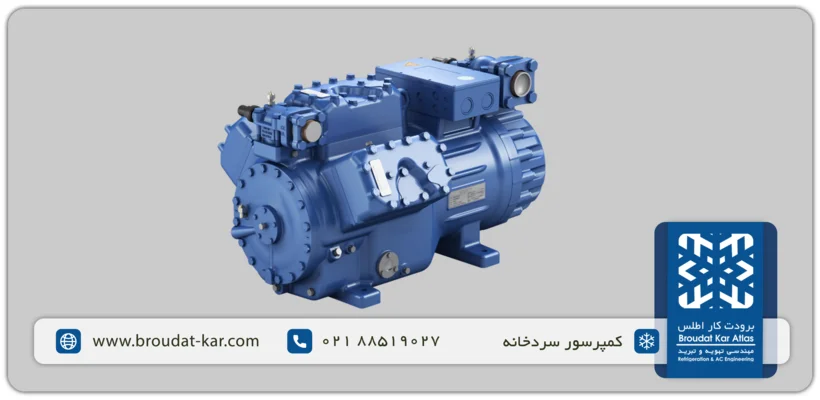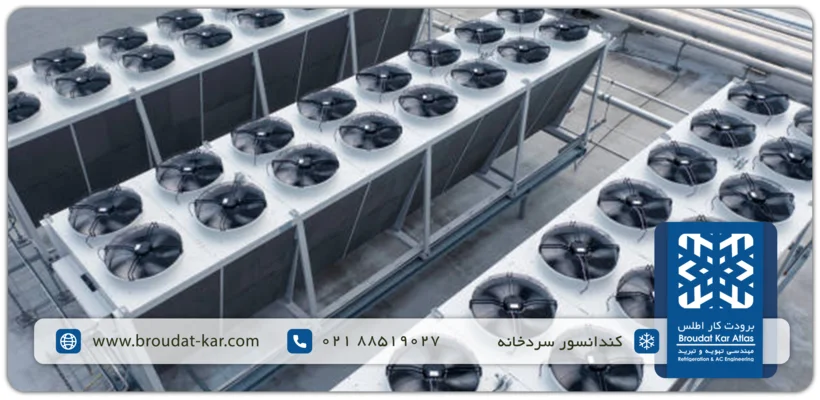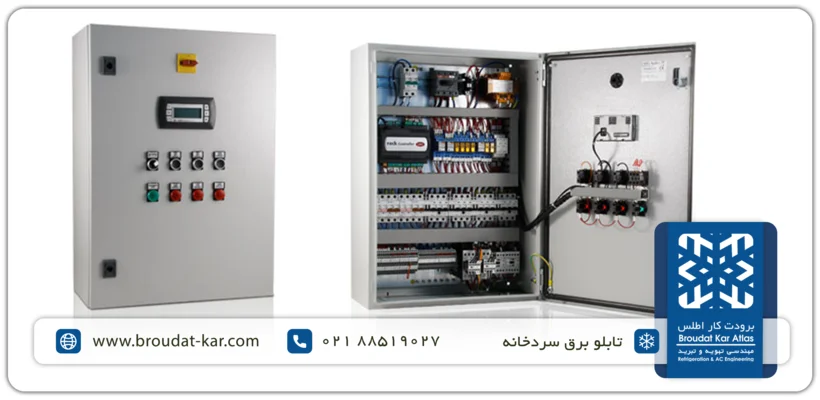What Is a Above Zero cold storage?
A Cold Store Above Zero is an insulated space designed for storing products at temperatures ranging from 0 to +15 degrees Celsius (+32 to +59 degrees Fahrenheit). This type of cold storage is commonly utilized due to its versatility in accommodating a wide range of products. Food preservation is a primary application of the refrigeration industry, where effective cooling and freezing processes help to reduce the activity of microorganisms and enzymes in products, thereby delaying spoilage. Additionally, crystallization of water within products reduces the presence of liquid water and inhibits microbial growth. Over 80% of products are typically stored in above-zero cold rooms, including fruits, vegetables, summer fruits, dried fruits, dairy products, sauces, beverages, medicines, and vaccines.
In simpler terms, cold storage facilities where products are stored at temperatures above zero degrees Celsius are referred to as above-zero cold storages. These facilities are primarily utilized for storing fruits, vegetables, as well as certain medicines and chemicals.
Above-Zero Cold Storage: Applications and Significance
Above-Zero Cold Storage facilities are indispensable for industries reliant on refrigeration. Even products typically stored in sub-zero conditions may require above-zero cold rooms at various production stages. For instance, defrosting processes are conducted in above-zero cold rooms, as are pre-cooling operations aimed at removing field and primary heat from products.
The significance of above-zero cold storage extends across industries dealing with perishable items requiring precise temperature control to preserve quality, freshness, and shelf life. These sectors encompass agriculture, food processing, pharmaceuticals, and various manufacturing industries.
Above-Zero Cold Storage: Vital for Agriculture and Horticulture
In agriculture and horticulture, above-zero cold storage facilities play a crucial role in preserving fresh produce. Fruits, vegetables, summer crops, herbs, flowers, and plant seeds require specific temperature conditions to maintain their health and quality. Above-zero cold storage provides an optimal environment to slow down natural ripening and decay processes, thereby extending the shelf life of these perishable items.
Pre-cooling certain products like fruits immediately after harvesting in above-zero cold rooms helps preserve their quality and prolong their usability. Additionally, maintaining products in above-zero cold storage serves as a valuable tool for gardeners and farmers to regulate market supply and demand, enhancing overall efficiency in the agricultural sector.
Above-Zero Cold Storage: Vital for Dairy and Beverage Industries
In the dairy and beverage sectors, maintaining product quality and freshness is paramount, and above-zero cold storage plays a crucial role in achieving this goal. While subzero cold storage is essential for many industries, certain dairy products and beverages, such as cheese, yogurt, and specific beverages, require storage at temperatures above freezing to preserve their integrity and prevent spoilage. For further insights on this topic, please refer to the dairy cold store.
Above-Zero Cold Storage: Essential for Pharmaceutical Applications
Above-zero refrigerators, particularly drug refrigerators maintained between 8 to 4 degrees Celsius, are integral to preserving the quality and efficacy of temperature-sensitive medications in the pharmaceutical industry. Cold rooms designated for medicine storage often require a separate unit reserved for emergencies, and they may also necessitate adherence to specific hygiene standards to ensure product integrity and safety.
Products Suitable for Above-Zero Cold Room Storage
Wide-ranging items spanning fruits, dairy products, medicines, and certain chemicals find suitability for storage within above-zero cold rooms. Below are the key products commonly stored in above-zero cold rooms, further details regarding suitable temperature and humidity levels can be found on the cold storage temperature page.
Types of Above-Zero Cold Storage
Above-Zero Cold Storage for Fresh Products
Storing fruits, vegetables, fresh flowers, and plants in above-zero cold storage extends their shelf life by slowing down the ripening and spoilage processes. Maintaining a controlled temperature slightly above zero degrees Celsius preserves the texture, taste, and freshness of items like avocados and leafy greens, ensuring market supply and retaining nutritional value.
Above-Zero Cold Storage for Dairy Products
Products such as cream, cheese, and yogurt require storage in above-zero cold rooms to prevent spoilage. Temperatures ranging from +1 to +4 degrees Celsius are necessary to uphold the freshness and quality of dairy products, preserving their taste and consistency.
Above-Zero Cold Storage for Medicines and Vaccines
Certain medicines, medical kits, and vaccines must be stored at temperatures between +4 to +8 degrees Celsius, also known as refrigerated medicines, to maintain their efficacy. However, freezing should be avoided as it may compromise their performance.
Above-Zero Cold Storage for Waste Management
In sports complexes, universities, and restaurants, effective waste management is crucial. Utilizing above-zero cold rooms to store waste until disposal helps prevent the release of unpleasant odors and reduces bacterial growth, aligning with health department regulations for larger establishments.
Above-Zero Cold Storage for Temperature-Sensitive Materials in Industry
Industries dealing with battery cooling during production, certain chemicals, semiconductors, or materials used in research laboratories may require controlled cooling without freezing. Above-zero cold storage provides a precise option for maintaining optimal and effective temperature control in these cases.
Above-zero cold storage serves diverse purposes, ensuring the preservation of perishable and sensitive items requiring controlled temperatures. From preserving product freshness to safeguarding the potency of medicines and managing waste in commercial settings, this storage solution plays a crucial role in maintaining the integrity, quality, and safety of various products and essential materials across industries and daily operations.
An above-zero cold room is a controlled environment kept at a temperature above freezing, typically ranging between +1 and +10 degrees Celsius (+34 and +50 degrees Fahrenheit). This type of cold storage serves multiple purposes, including the preservation of perishable goods such as fruits, vegetables, and medicines that necessitate low temperatures without freezing to uphold their quality.
Above Zero Cold Storage Equipment
Constructing a cold storage facility above zero requires two main types of refrigeration equipment along with auxiliary components. The following provides a detailed description of the necessary equipment for a cold storage facility operating above zero degrees Celsius.
Above-Zero Cold Room Refrigeration Equipment
The primary equipment required for constructing above-zero cold storage primarily consists of refrigeration equipment, including compressors, heat exchangers, electrical and control panels, insulation panels, and cold storage doors, among others.
Above Zero Cold Storage Compressor
The compressor serves as the cornerstone of a cooling cycle and comes in various types, such as hermetic, semi-hermetic, and open type. The choice of compressor type and power is typically made by experts based on factors like the cold storage capacity and available electrical conditions.
Refrigeration compressors operate within different temperature ranges, with some designed for mid-range temperatures. This versatility enables them to function effectively both above and below zero degrees Celsius.
Above Zero Cold Storage Condenser and Evaporator
The condenser and evaporator serve as heat exchangers within the cold room, with the evaporator absorbing heat from the stored products and the cold room space, while the condenser releases this heat along with the heat from the compressor to the surrounding environment. These components are selected based on factors such as the type of products stored, cold storage capacity, refrigerant type, and defrost method for each cold storage unit.
In industrial cold storage facilities, the condenser and evaporator are typically custom-designed and manufactured for each project. However, for small and commercial cold storage setups, standard sizes are available. Heat exchangers may come in various types, including fan type (air cooled), shell and tube (water cooled), and plate type.
Above Zero Cold Room Electrical Panel
The electrical panel of a cold room is tasked with distributing electricity to various electrical components, including motors, compressors, fans, and more. Each consumer within the panel is equipped with a separate thermal or bimetal switch designed to cut off power if the permitted amperage is exceeded. Additionally, the electrical panel of the above-zero cold room is responsible for controlling the operation of the equipment, ensuring efficient and reliable performance.
Auxiliary Equipment for Above Zero Cold Storage
In above-zero cold storage facilities, auxiliary equipment such as humidifiers or dehumidifiers plays a crucial role. These devices are essential for regulating humidity levels within the cold room, especially for storing products where humidity control is critical. Maintaining optimal humidity levels is integral to preserving the quality and freshness of stored items in above-zero cold storage environments.
Above Zero Cold Storage: Pallet Trucks and Forklifts
Efficient storage operations in above-zero cold storage facilities require the use of appropriate machinery for handling cargo. Pallet trucks and forklifts play a crucial role in facilitating the transportation of goods within the cold storage environment, aiding in the loading and unloading of pallets or containers. While manual stacking may suffice in smaller cold storage facilities, medium-sized cold storages often utilize pallet trucks, whereas industrial-scale cold storages necessitate the use of forklifts for efficient stacking at elevated heights. These equipment options ensure smooth and streamlined operations within above-zero cold storage facilities.
Shelving Systems and Box Pallets for Above Zero Cold Storage
In above-zero cold storage facilities, the design of shelving systems plays a critical role in optimizing storage space and facilitating organized product storage. Typically, box pallets are utilized for this purpose, although more advanced shelving options are also available, albeit at a higher price point. These shelving systems and box pallets ensure efficient utilization of space within the cold room, enabling systematic storage of various products and contributing to enhanced organization and accessibility.
Monitoring System for Above Zero Cold Storage
An essential component of above-zero cold storage facilities is the monitoring system, which ensures the continuous tracking of temperature levels. Equipped with sensors and alert mechanisms, this system promptly notifies responsible personnel in case of any deviation from the preset temperature range. By providing real-time alerts, the monitoring system enables swift action to maintain product integrity and addresses any potential issues promptly, ensuring the optimal storage conditions required for preserving product quality and safety.
Lighting for Above Zero Cold Storage
Adequate lighting is crucial in above-zero cold storage facilities to ensure safety during loading and unloading activities. It’s essential to use lighting fixtures with suitable protection against the humidity and temperature conditions within the cold room. Typically, LED or low-power lamps are preferred options as they generate minimal heat and are energy-efficient. By choosing the right lighting solutions, cold storage operators can maintain visibility and safety while minimizing the risk of accidents in the controlled environment of the cold room.
Pricing for Above Zero Cold Storage
Determining the price of a cold room above zero involves various considerations, including its dimensions, capacity, refrigerant type, refrigeration system, insulation, and door type. To estimate the cost accurately, several steps are typically followed:
- Assessing the customer’s needs and conditions, such as cold storage capacity, product type, geographical location, and required facilities.
- Estimating the dimensions of insulation and the cold room door.
- Determining the power and type of compressor, evaporator, and condenser for the cold storage.
- Sizing and designing valves, control devices, and electrical panels for the cold room.
- Estimating assembly and installation costs.
For small and medium-sized cold storages, Atlas Refrigeration Company provides rough annual estimates, which can be found on their cold storage price page. However, for industrial refrigerators and ammonia refrigerators, due to the technical complexity and equipment variability, it’s necessary to evaluate each project individually to provide an accurate price estimate. Contact us for more information on pricing for industrial cold storage solutions.
Final Words on Above-Zero Cold Room
With over 30 years of expertise as a provider of above-zero cold storage solutions, Atlas Refrigeration Company stands ready to tailor the perfect solution to meet your specific requirements and budget. Leveraging our extensive experience in executing numerous turnkey projects for both public and private clients, we offer comprehensive services including design, construction, implementation, operational training, and after-sales support. Count on us to deliver high-quality cold storage solutions that meet your needs effectively and efficiently.
Commercial cold rooms are primarily used for retail and small business purposes, whereas industrial cold rooms are designed for larger-scale needs, including manufacturing and processing industries.
Yes, many businesses and organizations build high-capacity industrial cold storage facilities and rent out their surplus capacity for specific periods. This allows for the rental of cold storage to meet temporary or seasonal needs.
Yes, some cold stores use renewable energy sources like solar and wind to reduce energy consumption. For more information, it’s best to contact companies specializing in this field. Cold stores typically require three-phase electricity, and the optimal use of renewable energy depends on the geographical location and engineering studies of the site.
Related posts
Above Zero Cold Storage
Portable Cold Store; Design and Construction of Portable Cold Store + Price The portable cold room, also known as
What Is Meat Cold Storage? Meat cold storage, also known as a meat refrigeration facility, is a specialized center dedicated
What is dairy cold storage? Dairy cold storage stands as a pivotal element within the dairy industry, crucial for the
What Is Chicken Cold Storage? Chicken cold storage refers to specialized equipment designed for preserving poultry products like chicken
Fish and Shrimp Cold Storage Systems – Preserving Freshness Fish and shrimp cold storage facilities play an important role in
What is Fruit Cold Storage? A Fruit cold storage is a specialized facility designed to store fruits and vegetables
